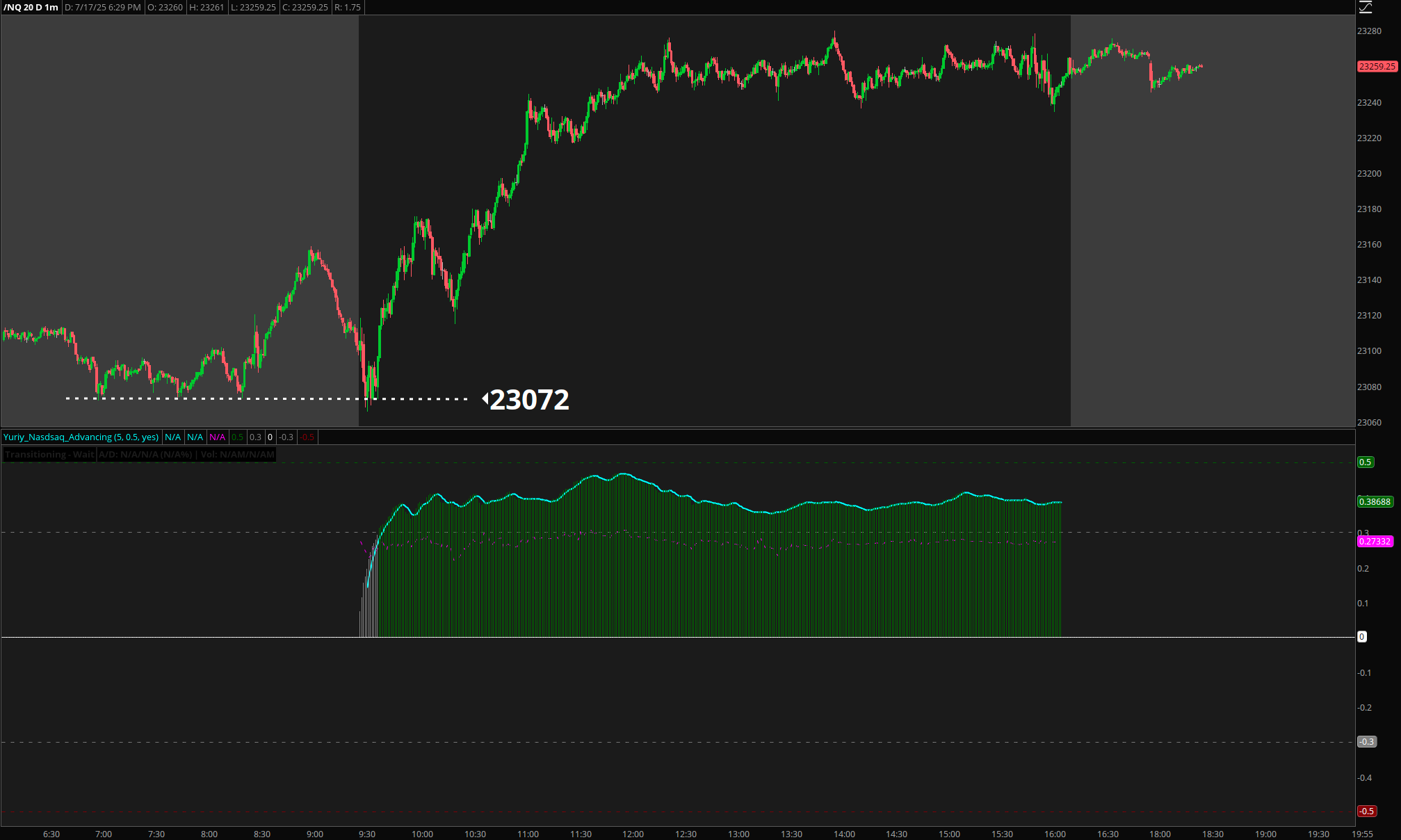Bull Market Dips: The Setup Every Trader Needs to Master
In a market that’s been hitting new all-time highs consistently, the playbook is clear: bulls are in control, and dips get bought. Today’s NQ session delivered a perfect example of how to identify and capitalize on these high-probability buying opportunities when the market briefly tests support.
The key wasn’t just watching price action at the 23072 support level - it was understanding what the advancing-declining issues indicator was telling us about the underlying market strength even as prices dipped.
Pre-Market Context: Setting Up the Trade
The pre-market session established 23072 as a critical support level for the NQ. This level had been tested multiple times in overnight trading, creating a zone where buyers were clearly stepping in.
In a bull market environment like we’re experiencing, these support levels become even more significant because:
- Institutional buyers are actively looking for dips to add positions
- Retail FOMO creates buying pressure on any weakness
- Technical traders are watching these levels for bounce plays
- Market momentum remains strongly bullish from recent all-time highs
The Opening Dip: When Price Tells One Story
Right after the market opened, we saw exactly what seasoned traders expect in a bull market - a brief dip that tested the resolve of buyers. The NQ dropped to touch that critical 23072 support level, creating what appeared to be a moment of weakness.
But here’s where most traders miss the real story: price action alone doesn’t tell you everything. While the charts showed a dip, the real intelligence came from looking beneath the surface at what individual stocks were actually doing.
Market Internals: The Real Story Behind the Dip
This is where the advancing-declining issues indicator became crucial. While the NQ was testing support at 23072, the advancing-declining issues data was painting a completely different picture:
The number of advancing stocks was actually expanding during the price dip.
Think about what this means:
- Individual stocks were moving higher even as the index dipped
- Breadth was improving while price was weakening
- This created a bullish divergence between price and internals
This divergence is exactly what smart money looks for in bull markets. When the overall index dips but individual stocks are advancing, it signals that:
- The selling pressure is limited and shallow
- Buyers are stepping in across individual names
- The dip is likely to be short-lived
- A bounce is highly probable
The Perfect Entry: Timing the Bounce

The moment the NQ started to bounce back up from 23072, all the pieces aligned:
- Price action: Clear bounce off established support
- Market internals: Advancing-declining issues showing strength
- Market context: Bull market environment favoring dips
- Volume: Buying volume increasing on the bounce
This created what we call a high-probability setup - multiple factors confirming the same directional bias.
Trading Applications: How to Use This Setup
Entry Strategy
- Wait for the bounce: Don’t try to catch the falling knife
- Confirm with internals: Check advancing-declining issues for divergence
- Use support levels: Pre-market levels provide clear reference points
- Volume confirmation: Look for increased buying volume on the bounce
Risk Management
- Stop below support: 23072 was the line in the sand
- Quick decision: In fast markets, be ready to act or step aside
- Size appropriately: Bull market dips can be volatile
Exit Strategy
- Take profits into strength: Bull market bounces can be powerful
- Trail stops higher: Let winners run in trending markets
- Watch for resistance: Previous highs become profit-taking zones
Market Context: Why This Works in Bull Markets
The advancing-declining issues divergence is particularly powerful in bull market environments because:
Strong Underlying Demand
When individual stocks are advancing during index weakness, it shows that buying interest remains strong across the market. This broad-based strength typically leads to quick recoveries.
Institutional Behavior
Large institutions often use index weakness to accumulate positions in individual stocks. This creates the divergence we saw today and typically results in swift bounces.
Technical Confluence
Support levels become self-fulfilling prophecies in bull markets as more traders watch these levels and act on them. The combination of technical support and positive internals creates high-probability setups.
Key Takeaways for Future Sessions
- Don’t ignore market internals - Price action alone doesn’t tell the complete story
- Advancing-declining issues can provide early warning of market direction changes
- Pre-market support levels remain relevant during regular trading hours
- Bull market dips are opportunities, not warnings, when supported by good internals
- Multiple confirmations create higher-probability trades than single signals
The Bigger Picture: Bull Market Playbook
Today’s trade exemplifies how to approach bull market sessions:
- Expect dips to be bought - Don’t fight the primary trend
- Use internals for confirmation - Look beyond just price action
- Be ready to act quickly - Good setups don’t last long in strong markets
- Respect support levels - They matter more in trending markets
When you combine solid technical analysis with market internals like advancing-declining issues, you can spot opportunities that others miss. The market gave us everything we needed: a clear support level, positive divergence in the internals, and a strong bull market backdrop.
What to Watch Moving Forward
As we continue in this bull market environment, keep watching for:
- Similar support bounces at key technical levels
- Advancing-declining divergences that signal underlying strength
- Volume confirmation on bounces and breakouts
- Institutional buying during weakness
The key is combining these elements into a complete picture rather than relying on any single indicator. Today’s NQ session showed exactly how this approach can lead to high-probability trading opportunities.
Remember: in bull markets, the bias is higher, but the execution still requires precision. Use support levels, confirm with internals, and always manage your risk appropriately.